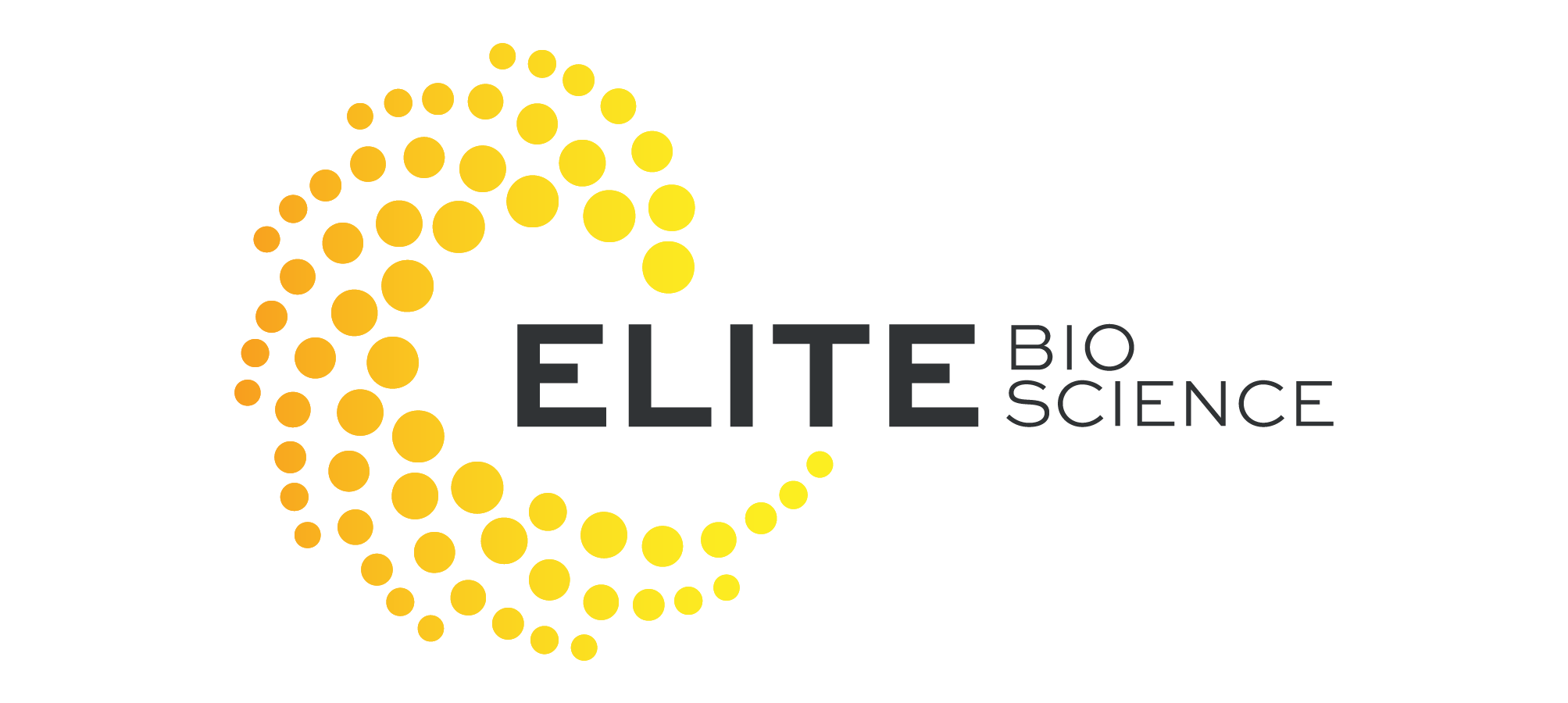A Guide to Peptides for Healing and Recovery
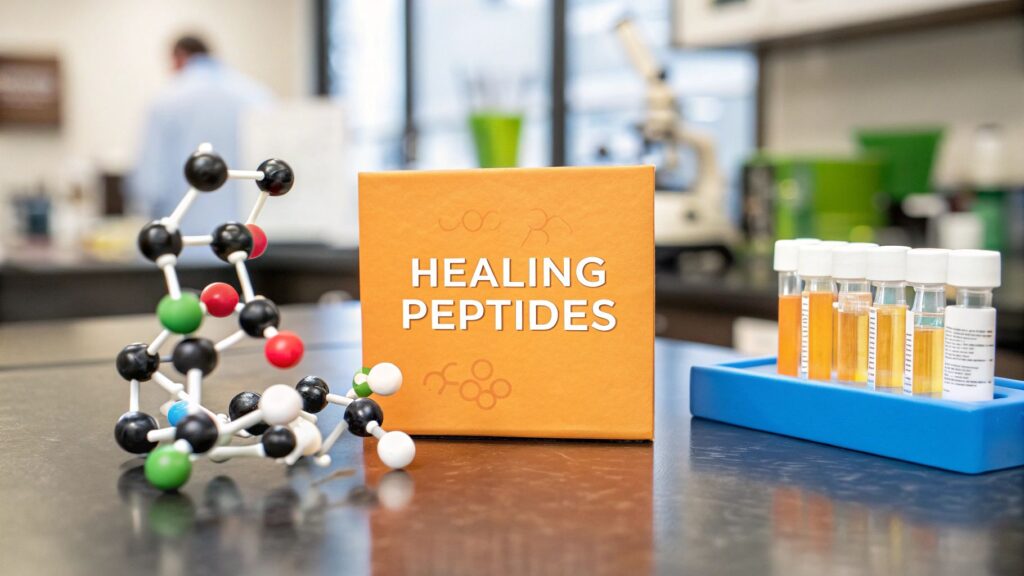
When you hear the term "healing peptides," you might picture something complex or artificial. But the truth is, these are simply short chains of amino acids that act as your body's own natural messengers, sending out specific instructions to cells to kickstart repair and dial down inflammation.
Think of them less like a foreign substance and more like a targeted signal that amplifies your innate ability to recover from an injury.
Understanding Peptides: Your Body’s Healing Messengers
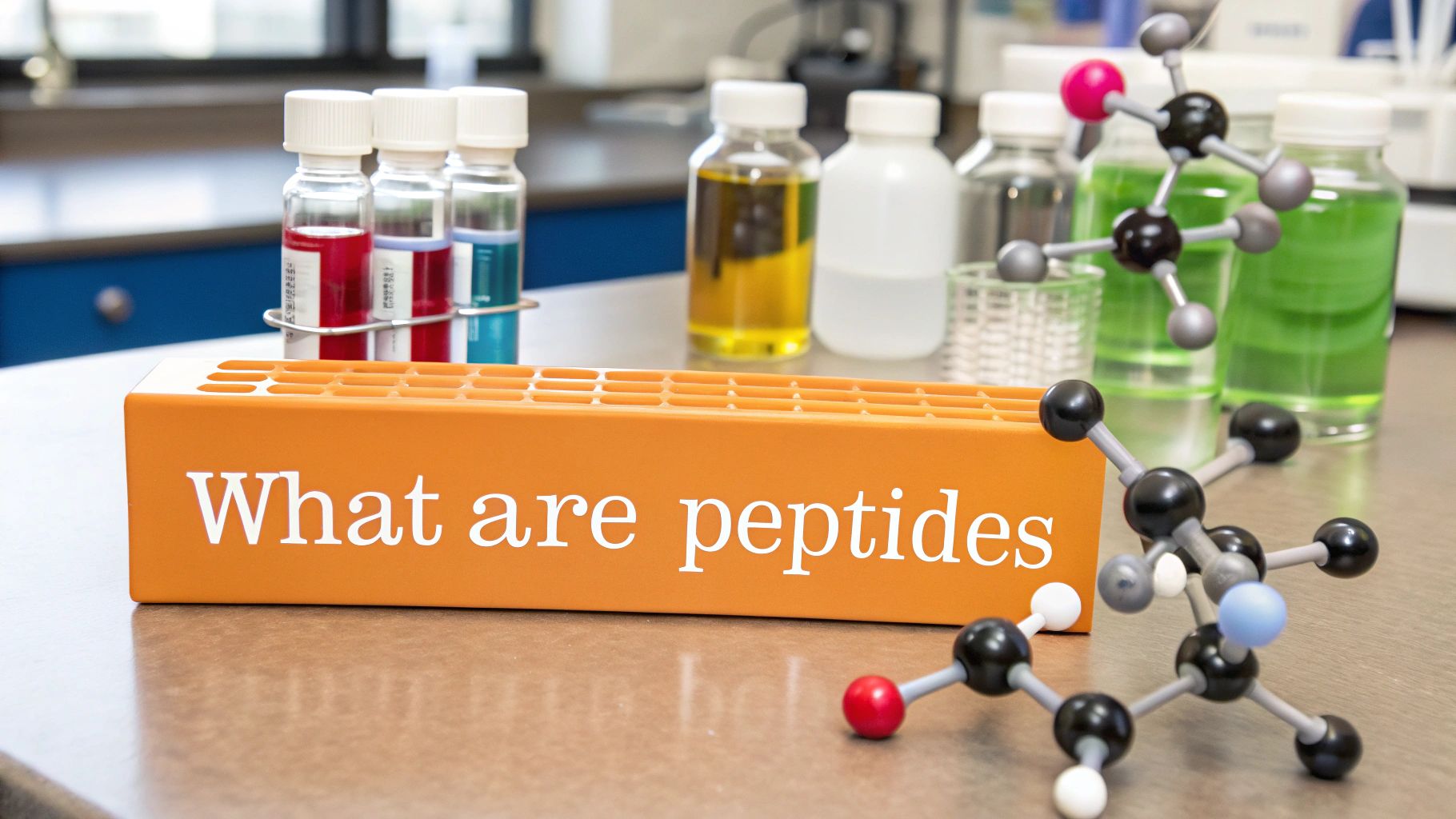
Imagine your body is a massive, intricate construction site. An injury—like a torn ligament or a deep cut—is like an unexpected structural failure. Your body's natural response is to dispatch a crew to fix the damage, but sometimes the process can be slow, disorganized, and chaotic.
Healing peptides are like a highly skilled foreman arriving on the scene.
These peptides don't do the heavy lifting themselves. Instead, they deliver precise, targeted instructions—almost like text messages—to the construction crew (your cells). These messages tell the cells exactly what to do, where to go, and how to work together to speed up the recovery process efficiently.
The Role of Biological Signals
Peptides aren't a new or foreign concept; they are absolutely fundamental to how your body operates. Every single day, your body produces thousands of different peptides to regulate functions from digestion to hormone production. When you get hurt, specific signaling molecules are released to manage the entire healing process.
Peptide therapy simply introduces a concentrated, therapeutic dose of these specialized messengers to amplify and direct the body's existing repair efforts. It’s an approach that works with your body, not against it.
This targeted signaling can command cells to perform several critical tasks for healing:
- Build new blood vessels (angiogenesis): This is like building new supply roads directly to the damaged area, delivering the oxygen and nutrients needed for reconstruction.
- Reduce excessive inflammation: While some inflammation is a necessary part of the initial response, peptides help calm the chaos, allowing the rebuilding phase to begin sooner and more effectively.
- Synthesize collagen: They instruct cells to produce more collagen, which is the "concrete and steel" that forms the structural foundation of your skin, tendons, and ligaments.
By sending these clear, direct instructions, healing peptides help organize and accelerate the entire repair sequence. They don't just mask symptoms; they actively direct the reconstruction of damaged tissue right at the cellular level.
A Natural Enhancement to Recovery
Ultimately, using peptides for healing is about optimizing a process your body already knows how to do. It’s an enhancement, not a replacement, for your innate recovery mechanisms.
Whether you're recovering from a tough sports injury, post-surgical trauma, or just the chronic wear and tear of life, these powerful molecules can help guide your body toward a faster, more complete recovery. When you understand them as biological messengers, the science is demystified, and their true potential becomes clear.
To give you a quick overview, here are some of the most well-known healing peptides and what they're typically used for.
Key Healing Peptides at a Glance
| Peptide | Primary Healing Function | Commonly Used For |
|---|---|---|
| BPC-157 | Systemic tissue repair, anti-inflammatory | Gut health, tendon/ligament injuries, muscle strains |
| TB-500 | Promotes cell migration and tissue regeneration | Muscle repair, wound healing, reducing inflammation |
| GHK-Cu | Stimulates collagen production, antioxidant | Skin rejuvenation, hair growth, wound healing |
| Ipamorelin/CJC-1295 | Stimulates growth hormone release | Recovery, muscle growth, anti-aging, fat loss |
This table is just a starting point, of course. Each peptide has a unique profile, but it illustrates how different "messengers" can be used to target specific recovery goals. We'll dive deeper into these and others throughout this guide.
How Peptides Accelerate the Healing Process
To really get why peptides for healing are so effective, you have to see them as more than just simple messengers. They're the expert coordinators arriving at a disaster zone—say, a torn muscle or a fresh surgical incision—where the body's initial response is often pure chaos. Peptides bring order, directing the entire reconstruction effort with precision and speed.
They pull off this impressive feat by activating three core biological pathways. Each pathway tackles a different, vital part of the healing cascade, making the whole process faster, more efficient, and more complete.
The infographic below gives you a bird's-eye view of this process, from the first signal to the final tissue regeneration.
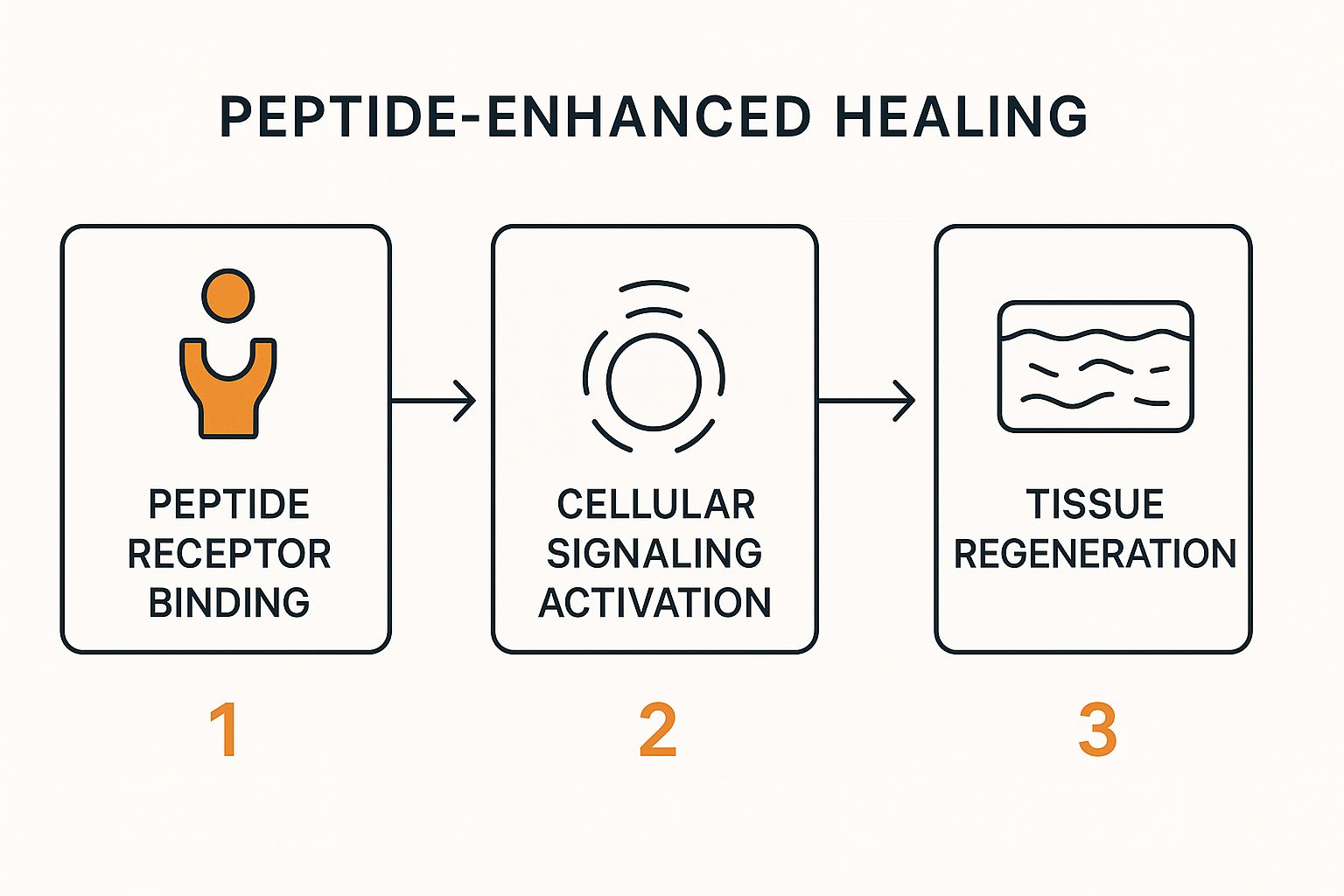
As you can see, peptides trigger a domino effect. It starts with binding to a receptor and ends with the physical rebuilding of the damaged area.
Building Supply Lines Through Angiogenesis
The first rule of any big repair job? Get resources to the workers. In the body, this happens through a process called angiogenesis, which is just a fancy term for creating new blood vessels. When tissue is injured, its circulation is often cut off, starving it of the oxygen and nutrients it desperately needs to heal.
Peptides like BPC-157 are masters of angiogenesis. They send out signals that tell the body to build new blood vessels right into the heart of the damaged tissue.
Think of it like constructing brand-new, high-speed supply roads to a remote construction site. These new vessels deliver a rush of oxygen, nutrients, and other healing factors that are absolutely essential for cellular repair. Without this fresh blood flow, healing grinds to a halt.
Calming the Chaos with Anti-Inflammatory Signals
Inflammation is a necessary alarm bell—it’s the body’s way of shouting, "Hey, we've got an injury here!" But when that alarm keeps blaring long after the crisis has passed, it becomes a problem. Chronic inflammation is like having emergency sirens wailing nonstop, preventing the repair crews from even getting to the site.
Many healing peptides have powerful anti-inflammatory properties. They don't just put a bandage on the problem; they go to the cellular level to modulate the inflammatory response itself.
Peptides don't just mask symptoms; they actively direct the reconstruction of damaged tissue.
This intelligent signaling helps dial down the excessive inflammation, which in turn reduces swelling and pain. By creating a calmer, more organized environment, peptides allow the body to shift smoothly from the initial cleanup phase to the crucial rebuilding phase. It's a hallmark of efficient healing.
Reconstructing the Foundation via Collagen Synthesis
Once the supply lines are open and the initial chaos is under control, the real work begins: rebuilding the damaged structure. For tissues like skin, tendons, ligaments, and muscle, the primary building block is collagen. Peptides like GHK-Cu are famous for their ability to kickstart collagen production.
They send direct orders to specialized cells called fibroblasts, telling them to ramp up the manufacturing of this vital structural protein. This command leads to stronger, more resilient tissue repair and can dramatically reduce the formation of weak, disorganized scar tissue. It's the difference between a flimsy patch job and a complete structural reinforcement.
This targeted approach to healing is what's driving so much excitement and growth in the medical world. The global peptide therapeutics market was valued at around USD 117.26 billion and is expected to more than double to USD 260.25 billion by 2030. This boom is fueled by their effectiveness in managing chronic conditions where targeted healing is a game-changer. You can read the full research about the peptide therapeutics market to see the data behind this trend.
Meet The Most Effective Healing Peptides
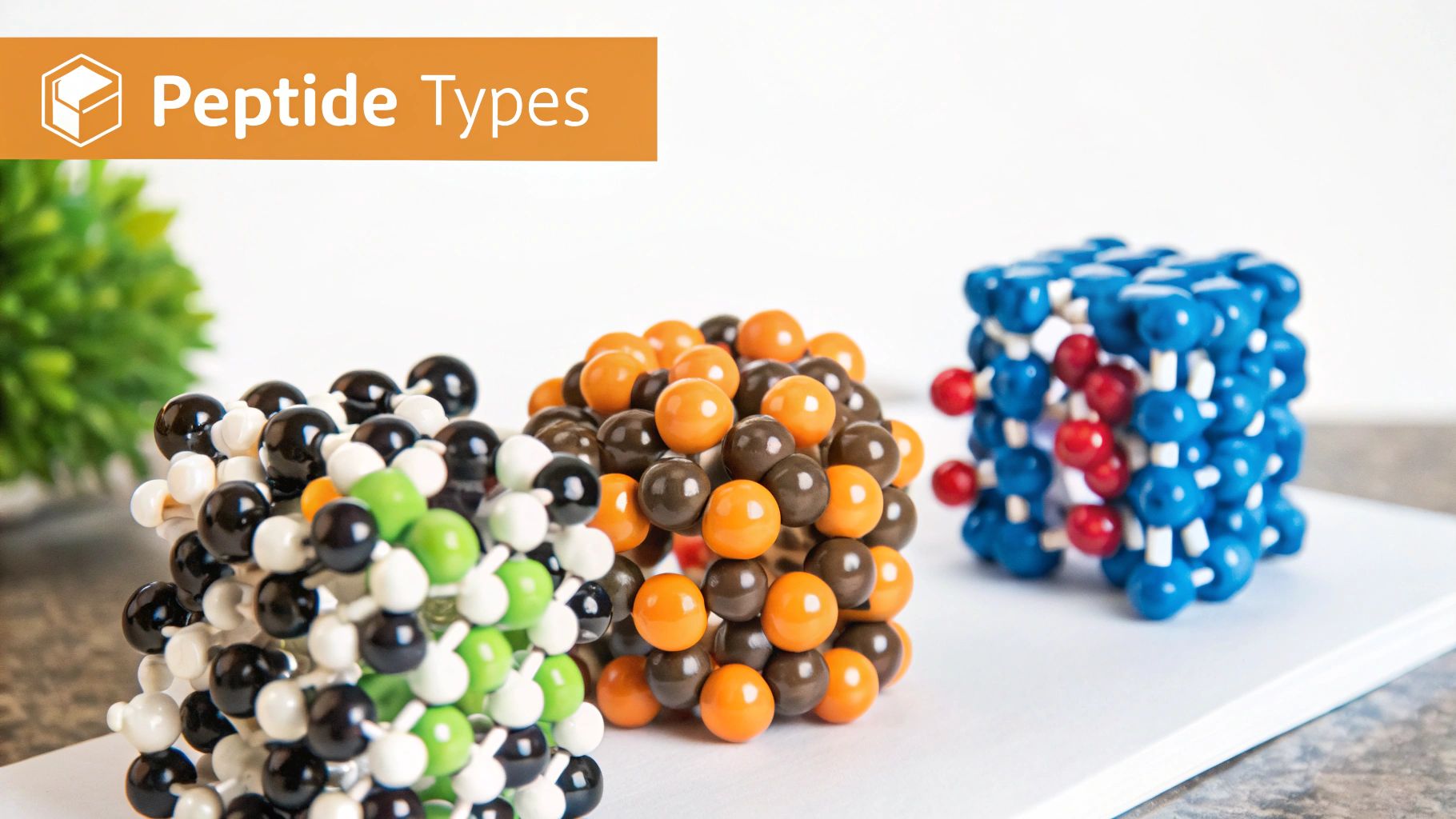
Now that we know peptides for healing act like your body's cellular project managers, let's get to know the star players. While your body uses countless peptides, a few have really stood out for their impressive regenerative powers.
Think of these as the elite special forces of your internal repair crew. Each one has a unique skillset, perfectly suited for different missions—from mending a stubborn tendon tear to revitalizing your skin. We'll focus on three of the most researched and effective ones: BPC-157, TB-500, and GHK-Cu.
Understanding what makes each molecule tick is the key to appreciating how they can be used to target specific recovery goals.
BPC-157: The Systemic Repair Specialist
BPC-157, which stands for Body Protection Compound-157, is easily the most famous healing peptide out there. It was originally discovered in human gastric juice, where its main job is to protect and heal the gut lining. That origin story tells you a lot about its power—it’s a master at repairing delicate, vital tissues.
But what makes BPC-157 so versatile is that its healing abilities aren't just limited to the gut. It has a systemic, or body-wide, healing influence.
Its primary mechanism of action is promoting angiogenesis, which is the creation of new blood vessels. By building new pathways for blood to reach an injury, BPC-157 makes sure damaged tissues get the oxygen and nutrients needed for rapid repair. This makes it a game-changer for injuries that are notoriously slow to heal due to poor blood flow, like tendon and ligament tears.
BPC-157 acts as a foundational repair agent. Its ability to accelerate blood vessel growth and reduce inflammation makes it a go-to for a wide array of injuries, from muscle strains to gut-related issues.
This peptide is often the first pick for athletes and anyone recovering from orthopedic injuries. Its broad-spectrum effects support the repair of muscle, tendon, ligament, bone, and even nerve tissue, making it a true workhorse in regenerative medicine.
TB-500: The Mobility And Soft Tissue Expert
While BPC-157 is known for its powerful, localized repair work, TB-500 works a bit differently. It’s a synthetic version of Thymosin Beta-4, a protein that plays a huge role in tissue regeneration and getting cells to move where they need to go. Its real strength lies in its ability to orchestrate the movement of repair cells to an injury site.
Imagine TB-500 as the air traffic controller of your healing process. When an injury happens, this peptide helps guide progenitor cells—the "blank slate" cells that can become various tissue types—directly to the damaged area. It also boosts the production of actin, a protein vital for cell structure and movement, which enhances cellular mobility.
This unique action makes TB-500 exceptionally good at healing widespread soft tissue damage and improving overall flexibility and range of motion.
- Muscle and Soft Tissue: It excels at repairing torn or strained muscles and other soft tissues.
- Wound Healing: It speeds up the closure of wounds by encouraging the migration of skin cells.
- Inflammation Control: Just like BPC-157, it helps manage inflammation, creating a better environment for repair.
Because it works systemically and focuses on cell migration, TB-500 is often used for larger injuries or for improving overall recovery and athletic performance. While BPC-157 is the targeted "spot welder," TB-500 is the systemic "renovation manager."
Many people find that combining BPC-157 and TB-500 creates a powerful synergistic effect. To learn more about how these two work together, you can find a detailed comparison in our guide on the BPC-157 and TB-500 stack.
GHK-Cu: The Skin And Nerve Regenerator
Our third healing powerhouse is GHK-Cu, a copper peptide with a completely different specialty. This peptide is naturally found in our plasma, but its levels drop off significantly as we get older. Its main claim to fame is its profound effect on skin health and regeneration.
GHK-Cu works by stimulating the production of collagen and elastin, the two essential proteins that give skin its structure, firmness, and elasticity. It also has potent antioxidant and anti-inflammatory properties, protecting the skin from damage and calming irritation.
But its benefits are more than just skin deep. GHK-Cu has also shown impressive abilities in nerve regeneration and even hair growth stimulation. By resetting the genes of damaged cells to a more youthful and regenerative state, GHK-Cu can:
- Minimize Scarring: It encourages the formation of healthy, organized tissue instead of scar tissue.
- Rejuvenate Skin: It tightens loose skin, improves elasticity, and reduces fine lines and wrinkles.
- Promote Nerve Repair: Studies suggest it can support the regrowth and repair of damaged nerve pathways.
This makes GHK-Cu an ideal peptide for post-surgical recovery, especially after cosmetic procedures, as well as for general anti-aging and skin health protocols.
To help you choose the right tool for the job, it helps to see these peptides side-by-side.
Comparison Of Popular Healing Peptides
This table offers a clear, at-a-glance comparison of BPC-157, TB-500, and GHK-Cu, highlighting their distinct advantages and primary use cases to help you understand where each one shines.
| Feature | BPC-157 | TB-500 | GHK-Cu |
|---|---|---|---|
| Primary Action | Angiogenesis & localized repair | Cell migration & systemic healing | Collagen synthesis & gene repair |
| Best For | Tendon, ligament, and gut injuries | Muscle strains, widespread damage | Skin, scar tissue, nerve health |
| Effect Type | Systemic but potent at injury site | Fully systemic and widespread | Primarily localized to application area |
| Key Benefit | Accelerates healing in low-blood-flow areas | Improves flexibility and mobility | Enhances skin quality and reduces scars |
As you can see, each peptide has a specific role. BPC-157 is your go-to for structural repairs, TB-500 manages systemic soft tissue recovery, and GHK-Cu focuses on rejuvenating skin and nerves. Understanding these differences is the first step in harnessing their full potential.
How Healing Peptides Work in the Real World
Understanding the science behind peptides for healing is one thing, but seeing how they actually deliver results is what really matters. These biological messengers are making their way from the lab into everyday life, helping people recover faster and more completely from a huge range of issues. From elite athletes to ordinary folks, peptides are becoming a key part of modern recovery.
These applications aren't just theoretical ideas; they target specific, common problems. By going after the root causes of slow healing—like poor blood flow and stubborn inflammation—peptides give us a way to actively manage and speed up the body's own repair crew.
Accelerating Recovery in Sports Medicine
For an athlete, recovery isn't just a break; it's a critical part of their job. A nagging injury like a ligament tear or chronic tendonitis can easily put a career on hold. This is exactly where peptides like BPC-157 and TB-500 have made a massive difference.
Athletes are using these peptides to tackle stubborn soft tissue injuries that are notoriously slow to heal. Think about a partial rotator cuff tear or Achilles tendonitis—these injuries often involve tissues that get very little blood, which severely limits the body's ability to fix them. Peptides help overcome this by promoting angiogenesis, which is the creation of new blood vessels, directly at the site of the injury. For athletes focused on building and repairing muscle tissue, you can explore our detailed guide on peptide therapy for muscle growth.
This targeted approach helps athletes:
- Slash downtime from common injuries like muscle strains and ligament sprains.
- Strengthen the repaired tissue, making it tougher and more resilient against future damage.
- Control chronic inflammation from overuse, which allows for more consistent and intense training.
Optimizing Post-Surgical Healing
Surgery, even when necessary, is a major trauma to the body. After any procedure, the goal is to heal as quickly and cleanly as you can, minimizing problems like excessive scarring and infection. More and more, peptides are being added to post-surgical plans to achieve just that.
After an operation, the body is on high alert. Peptides help organize a more efficient and orderly healing response. BPC-157, for instance, can speed up the closure of surgical wounds and improve the tensile strength of the healed tissue. GHK-Cu is especially valuable for minimizing scar tissue, encouraging the growth of healthy, organized collagen instead.
By working with the body’s own healing toolkit, peptides can lead to a smoother, faster, and more complete recovery from surgery, cutting down on both pain and the risk of long-term problems.
Managing Chronic Inflammatory Conditions
Not all healing is about fixing an acute injury. Millions of people live with chronic conditions where constant inflammation is the main enemy, causing ongoing pain and tissue breakdown. This can be anything from joint pain linked to arthritis to digestive issues like inflammatory bowel disease (IBD).
Peptides offer a promising way to dial down this chronic inflammatory response. BPC-157, which was originally studied for its ability to protect the gut lining, has shown a lot of potential for calming inflammation in the digestive tract. This same anti-inflammatory power can also help those with persistent joint pain, creating an internal environment that’s better for long-term health and comfort.
This therapeutic potential has fueled massive growth and interest. Since insulin, the first therapeutic peptide, was made in 1921, the field has exploded. With over 80 peptide-based drugs now approved worldwide, the market was valued at over USD 49 billion and is projected to climb to nearly USD 84 billion by 2034. You can discover more insights about the growing peptide therapeutics market on Statifacts.com. This shows a clear trend toward using these targeted molecules for complex health challenges.
Navigating Peptide Therapy Safely And Responsibly

The potential of peptides for healing is incredibly exciting, but this power demands responsibility. Diving into peptide therapy without proper guidance is like trying to navigate a complex medical landscape without a map. The single most important rule is to always work with a qualified healthcare professional who can design a protocol that is safe, effective, and legal for your specific needs.
This professional oversight isn't just a suggestion; it's non-negotiable. It's the only way to ensure you get a correct diagnosis, the right peptide for the job, and the precise dosing required for results. Trying to self-prescribe based on what you've read in online forums can be ineffective at best and dangerous at worst.
Sourcing: The Most Critical Safety Factor
Not all peptides are created equal, and where you get them from matters more than anything. The market is split into two completely different worlds, and understanding this distinction is crucial for your safety.
On one side, you have pharmaceutical-grade peptides. These are the real deal, sourced from licensed and regulated compounding pharmacies right here in the USA. They are prescribed by a doctor and undergo rigorous third-party testing to verify their purity, potency, and sterility. This is the only legitimate and safe path for human use.
On the other side, you'll find peptides sold online as "research chemicals only." These products are completely unregulated. They often come from overseas labs with zero quality control, and studies have shown they can be under-dosed, contaminated with harmful substances, or not even contain the active ingredient at all.
The lure of a cheaper price tag on an unregulated site is a dangerous trap. Using these products puts your health at direct risk and bypasses the essential medical guidance needed for safe and effective therapy.
Why Individualized Dosing And Administration Matter
There's no such thing as a one-size-fits-all approach to peptide therapy. Key factors like your body weight, the specific injury or condition, your overall health, and the peptide itself all influence the correct dosage. A medical provider is essential for crafting a protocol that maximizes benefits while minimizing any potential side effects.
Your provider will also give you clear instructions on proper administration, which is typically a subcutaneous injection. Using the correct technique is vital for making sure the peptide is absorbed effectively and for avoiding issues like infection or irritation at the injection site. For more detailed information, our comprehensive peptide dosage guide offers valuable insights into these protocols.
The rising interest in these therapies is clear from market trends. In North America, the peptide therapeutics market was valued at USD 16.69 billion and is projected to skyrocket to USD 38.21 billion by 2033. This growth is fueled in part by the high prevalence of chronic conditions, with over 60% of U.S. adults having at least one. As demand grows, so does the importance of safe, medically supervised access. You can learn more about these market projections to understand the full scope of this trend.
Your Questions Answered: A Practical Guide to Healing Peptides
As more people learn about peptide therapy, the practical questions start to surface. It's one thing to understand the science, but another to know what to expect in the real world. This section offers clear, straightforward answers to the most common queries we hear from people considering peptides for healing. The goal is to cut through the confusion and help you feel confident about this approach.
How Long Until I See Results from Healing Peptides?
This is probably the most common question, and the honest answer is: it depends. The timeline for results is deeply personal and hinges on a few key things: the type and severity of your injury, the exact peptide protocol you're on, and your overall health.
Many people report feeling a noticeable drop in pain and inflammation within the first one to two weeks. That's often the first sign that things are moving in the right direction.
However, for deeper structural repairs—think torn tendons, damaged ligaments, or significant muscle tears—the process is more of a marathon than a sprint. Seeing substantial improvements in tissue strength and function can take several weeks to a few months. It's important to remember that peptides are supporting a true regenerative process, not just masking the pain. Consistency is everything here.
Are Peptides for Healing Legal and Safe to Buy?
The legal landscape for peptides can be tricky to navigate. Here in the United States, many of the most effective healing peptides like BPC-157 are not FDA-approved for human use. Because of this, they are often sold online under the label "research chemicals only," which is a major red flag.
The only safe and legal way to get therapeutic-grade peptides is with a prescription from a licensed medical professional. Your doctor will then source them from a reputable, regulated compounding pharmacy that is held to strict quality standards.
Buying peptides from unregulated online vendors is a huge gamble. These products can be contaminated, under-dosed, or completely fake. At best, they won't work; at worst, they could pose a serious threat to your health.
What Are the Potential Side Effects?
Because peptides are designed to mimic your body's own signaling molecules, they generally have a very strong safety profile, especially when used under medical supervision. The most common side effects are minor, temporary, and nothing to worry about.
These usually pop up right at the injection site and can include things like:
- Mild redness or swelling
- A little bit of itching or irritation
- Minor discomfort
Less often, some people might experience temporary fatigue, mild water retention, or changes in appetite as their body adjusts to the new signals. Serious side effects are extremely rare, which is precisely why following a professionally guided protocol is so important. It ensures your response is monitored, keeping the entire experience safe and positive.
Ready to explore how targeted peptide therapy can optimize your recovery and well-being? At Elite Bioscience, we provide medically supervised access to high-quality, third-party tested therapies tailored to your unique goals. Start your confidential health assessment today and discover a smarter path to healing.
QUICK SEARCH
Make an account today to start your journey towards a better and healthier lifestyle.
